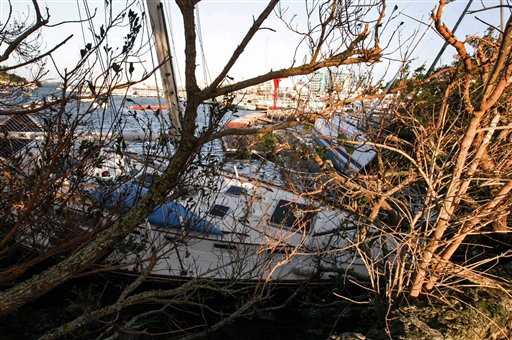The arrival of Tropical Storm Fay to Bermuda, less than a week ahead of Hurricane Gonzalo, may have helped to weaken the second storm which made landfall on the hurricane which the south-central coast of Bermuda Friday night, according to an analysis by AIR Worldwide.

“The storm weakened prior to landfall due to both lower sea surface temperatures and higher wind shear in the vicinity of Bermuda,” said Scott Stransky, manager and principal scientist at AIR Worldwide, in a media statement yesterday. “It is likely that Fay’s passage” directly over the island last week,” reduced the sea surface temperatures around Bermuda and allowed Gonzalo to be just slightly weaker than it might have been,” he said.
Describing the track of Gonzalo, AIR noted that “Bermuda literally passed through the eye of the needle,” explaining that the eye diameter was twice the length of Bermuda.
“When Gonazlo’s eye began to come onshore, the storm was still Category 3 with 115 mph winds, but by the time the very center passed overhead, Gonzalo had weakened to Category 2, with 110 mph winds,” said Stransky.
The catastrophe modeling notes that Gonzalo the third recorded Cat 2 (or above) storm to pass directly over the island of Bermuda since NOAA’s official hurricane database, HURDAT, began in 1851.
Hurricane Fabian, which caused $300 million in losses in 2003, was not one of the three. Fabian’s track was actually just west of the island; the center did not pass directly overhead.
Gonzalo’s winds were also lower than Fabian’s. According to AIR, a recurrence of Fabian today would cost the industry around $650 million.
The other Category 2 storms passing directly over Bermuda occurred in 1895 and 1922.
Gonzalo’s Damage
Reports of significant structural damage from Gonzalo in Bermuda are relatively scarce. Exceptions include an old recycling plant constructed of light metal and isolated instances of collapsed masonry walls.
According to AIR, buildings in Bermuda are designed to withstand sustained wind speeds up to 110 mph and gusts up to 150 mph. The codes are strictly enforced.
Stransky added: “Damage may also have been mitigated by the very fact that the very large—and very calm—eye of Gonzalo passed over Bermuda, which reduced the total number of hours of significant winds. Nevertheless, roof damage—ranging from a few blown off tiles to, in some cases, loss of nearly the entire roof—is fairly widespread.”
Among the more notable buildings that sustained roof damage are the House of Assembly, the police headquarters, the Visitor Centre in St. Georges, and the hospital (both the old and new wings). Damage was also sustained at the Bermuda Aquarium, Museum and Zoo, where the sheet metal roof of an exhibit hall was torn off.
The first reports of damage when daylight arrived on Saturday morning were dominated by downed trees and utility poles, which made roads impassable. According to the Bermuda Electric Light Company, or Belco, Gonzalo left 31,700 households in the dark.
Bermuda’s Causeway, which links Hamilton Parish on the mainland with the Bermuda International Airport in St. George’s Parish, appears to have been left largely intact by Gonzalo, although several sections of concrete block wall had been knocked down by high waves.
Fabian, in 2003, caused major damage to the Causeway, resulting in the loss of four lives. Fabian remains the strongest storm to impact Bermuda in 50 years.
No fatalities have been reported from Gonzalo’s impact in Bermuda.
High waves from Gonzalo also tossed about sailboats and yachts, tearing some away from their moorings and forcing them ashore, and sinking others. Coastal erosion has also been reported along the island’s south coast.
Source: AIR Worldwide





















 Artificial Intelligence Is Rewriting the Rules for Commercial Lines
Artificial Intelligence Is Rewriting the Rules for Commercial Lines  Why the Middle Market Matters and How Insurers Can Capture It
Why the Middle Market Matters and How Insurers Can Capture It  Good Times for U.S. P/C Insurers May Not Last; Auto Challenges Ahead
Good Times for U.S. P/C Insurers May Not Last; Auto Challenges Ahead  NOAA Announces Latest AI-Driven Global Weather Models
NOAA Announces Latest AI-Driven Global Weather Models 





